Atari Lynx
Top 10 Best Atari Lynx Games of All Time!
Before the Nintendo Game Boy was announced to the public in 1988, Atari was already developing a handheld system of their own with the help of Epyx. As more details of the Game Boy leaked out, Atari became increasingly certain that their Lynx would dominate the handheld market. After all, the Game Boy featured a monochrome screen, lacked a backlight, and was less powerful than the Lynx was. The Lynx boasted color graphics, a backlit screen, and networking capabilities, but these features came at a cost. Not only did it launch at a higher price then the Game Boy, but the Lynx also ate batteries. (It could drain six AA batteries in less than five hours, while the Game Boy could last 15 hours on just four AAs.) Consumers of all ages gravitated toward the Game Boy, leaving the Lynx with table scraps. The Lynx had no “Tetris-caliber” killer app, but the console was home to a number of excellent arcade ports and its library was filled with titles that the Game Boy couldn’t have handled.
10
Ms. Pac-Man
1990
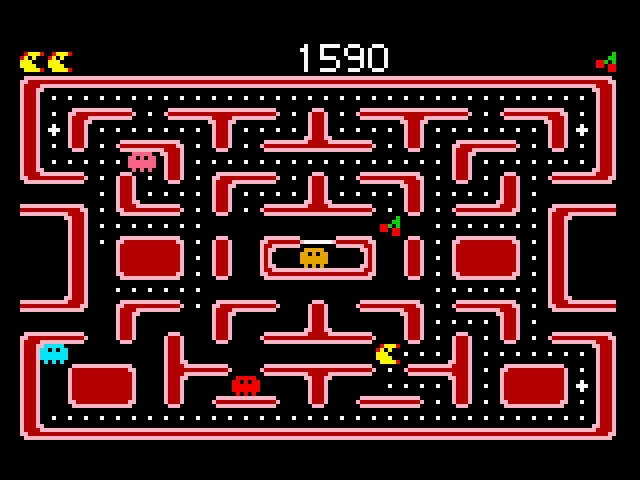
It doesn’t get more simplistic than Ms. Pac-Man. The entire game consists of eating dots and avoiding ghosts. Chimpanzees have even been trained to play the game! Despite its simplicity – or perhaps because of its simplicity – Ms. Pac-Man is still fun to play several decades after its initial release in the arcades. The ability to turn the tables on your ghostly foes by eating an “energizer” is still one of the most exhilarating actions in any game. The Lynx obviously runs at a lower resolution than the arcade version did, but it’s really not that big of a deal in the grand scheme of things and the game is still charming in its own right. Ms. Pac-Man’s trademark mole had to go, but the Lynx version retains the maze layouts and basic play mechanics that made the game so popular in the first place. Even the cinema scenes were carried over from the arcade. The Lynx version also contains a host of extra features that weren’t seen in arcades, including additional mazes and a new “speed boost” power-up. Had Atari found room for a two-player mode, Ms. Pac-Man would have ranked even higher on this list.
9
Rampage
1990
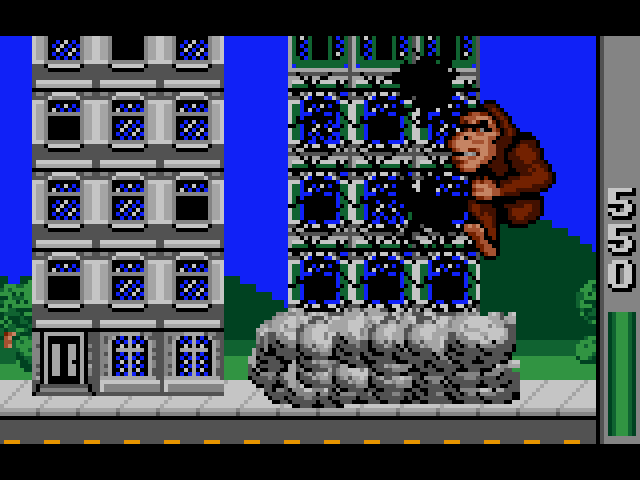
The premise of Rampage revolves around gigantic monsters attacking various cities. Players assume the role of these monsters, and find opposition from onslaughts of military forces. The objective in each stage is simply to reduce all of the buildings to rubble. To that end, players can climb up the sides of the buildings, smash windows, and butt-stomp skyscrapers into the ground. In addition to fending off military forces, players are also encouraged to eat civilians. In the original arcade version, players had the option of choosing between a giant ape, a giant lizard, and a giant werewolf. The Lynx version also adds a giant rat to the mix. The reason why a fourth character was added to the game was because the Lynx version actually supports four-player multiplayer action! Rampage is a repetitive game, despite boasting 128 stages, but the multiplayer options make the game feel less predictable and a lot more fun.
8
Lemmings
1993
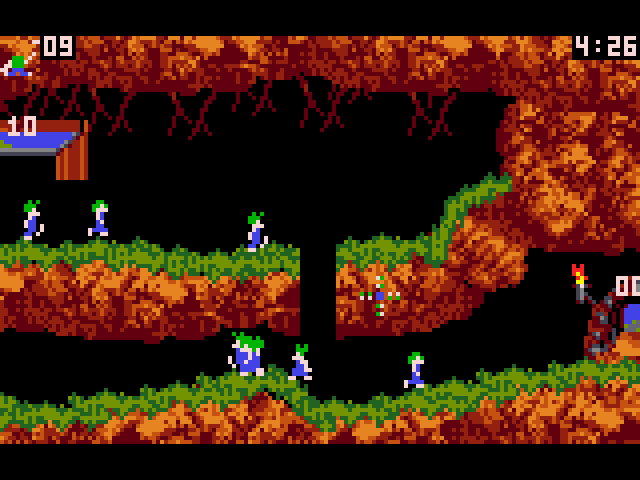
The goal in Lemmings is for players to guide groups of the dimwitted lemmings to designated exits. Since the lemmings are mindless creatures, it’s up to the player to give them direction and help them avoid various obstacles. Players can instruct the lemmings to dig through the ground, build staircases, or climb walls. The lemmings can also be given life-saving parasols that will allow them to float to safety. The game contains an impressive 120 levels, and strong problem-solving skills are required in the later stages. Unfortunately, the tiny screen on the Lynx gives the players a restricted view of the playing field. Keeping track of all of the lemmings can be almost impossible at times. To make matters worse, the cursor moves way too slow and the directional pad simply can’t match the speed or precision of the mouse. Thankfully, neither of these complaints could be considered “game breaking,” since the Lynx version of Lemmings allows players to move the cursor while the game is paused. This slows the game down somewhat, but players can make up time with the greatly-appreciated “fast forward” option. (The Lynx version of Lemmings was one of the first versions of the game to include such a feature.) The play mechanics work surprisingly well on the Lynx, and the game impresses from a technical level as well. The visuals are clean, the characters are well-animated, and the lemmings themselves have a lot of personality despite being only a few pixels tall. The game also features some of the best music ever heard on the platform.
7
Klax
1990
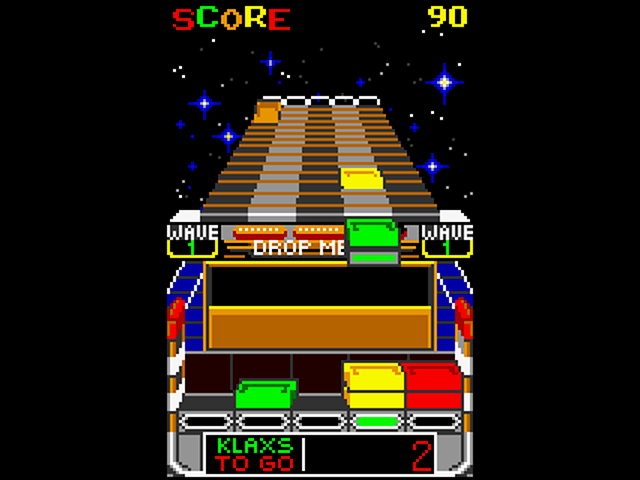
The Game Boy version of Tetris is possibly the single most important portable video game of all time. The easy-to-understand, “pick up and play” gameplay was the perfect fit for a handheld device, and the addicting nature of the game made it a killer app for the system. Klax was essentially Atari’s answer to Tetris. The goal in the game is to line up blocks into lines of similar colors in order to make them disappear. One thing that separates Klax from other puzzle games is its “conveyor belt” motif. Many puzzle games allow players to see the next piece ahead of time, but Klax gives players a more comprehensive look at their upcoming pieces. The pieces in the game all move along on a conveyor belt before they come into play, so players can manage the playing field to accommodate the upcoming pieces ahead of time. Multiple pieces move along the belt at the same time, so managing the upcoming pieces is nearly as important as managing the pieces that are already in play. One of the most interesting aspects about the Lynx version of Klax is that it supports a vertical screen orientation. (Players turn the Lynx on its side to play the game.) This was a bold design choice, considering that the original arcade version actually used a standard horizontal orientation. The vertical screen seems more appropriate for the game, even if it does make the Lynx feel somewhat unwieldy.
6
Ninja Gaiden
1991
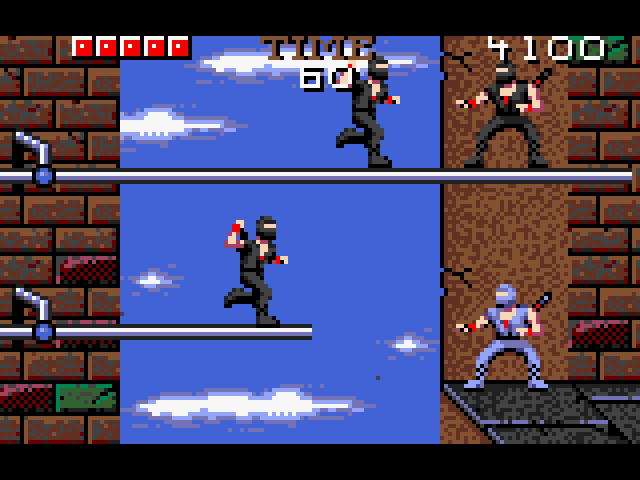
Those who grew up playing the NES version of Ninja Gaiden will undoubtedly notice that the Lynx version feels significantly different. That’s because the Lynx version is actually based on the original arcade game rather than the more-famous NES port. The Lynx version of Ninja Gaiden is a pretty standard side scrolling beat ’em up, and the game is not nearly as platform-centric as its NES counterpart. The action itself is a little slower on the Lynx than it was in the arcades, but it’s still a lot of fun to perform backflips, swing around street signs, and jump off walls. (Who doesn’t like kicking rival ninjas in the face?) The environments are pretty interactive as well, and players can shatter crates and phone booths by throwing opponents into them. The Lynx port of Ninja Gaiden does a commendable job of capturing the look and feel of the arcade original, and it’s easily one of the best action games on the platform.
5
Robotron: 2084
1991
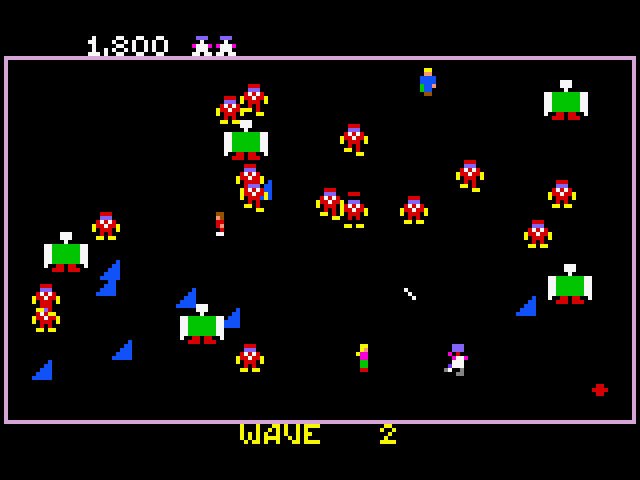
Robotron: 2084 is a revolutionary action game that was first released in arcades in 1982. The objective in the game is for players to defeat endless waves of enemy robots, rescue human survivors, and earn as many points as possible. Robotron was easily one of the most frantic action games of its era and actually made use of a dual joystick control scheme. The Lynx obviously doesn’t have multiple joysticks, but the developers at Shadowsoft came up with a creative solution to this problem. In the Lynx version, players move their character with the d-pad and rotate their character clockwise or counter-clockwise with the two action buttons. This effectively allows them to move in one direction while shooting in another. Given the amount of enemies on screen, it’s surprising how well the game works on the Lynx. The tiny sprites don’t have a lot of detail to them, but it’s still easy to distinguish between the robots and humanoids. Besides, you’ll be so busy trying to shoot your enemies that you won’t really have time to critique the graphics. Robotron: 2084 was one of the best arcade games of the ’80s and the Lynx version is just as addicting. I wasn’t sure how well the game would translate to a portable system, but Robotron: 2084 on the Lynx surpassed my expectations on every level.
4
California Games
1989
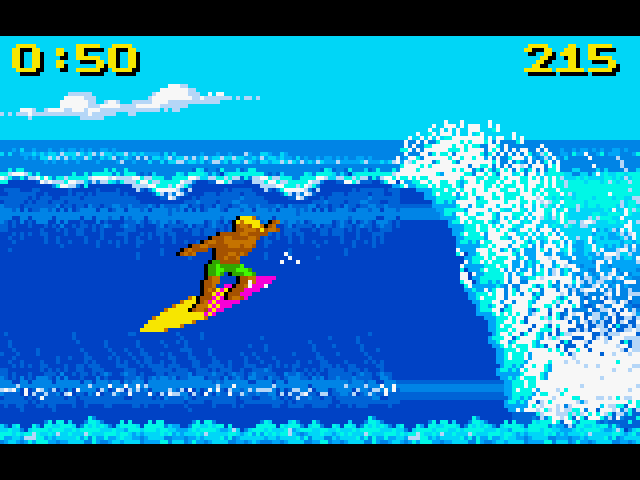
California Games was released on over a dozen gaming platforms, but it seems especially appropriate for the Lynx. The fact that the developers of the game (Epyx) also developed the Lynx hardware might have something to do with this. California Games is comprised of four individual events, and the mini-game concept seems perfectly suited for a portable system. The four included events (BMX, surfing, skateboarding, and footbag) show a surprising amount of variety, and each one challenges players in different ways. The events rely on reflexes and timing more so than memorization, which makes California Games easy to pick up and play. The most surprising aspect of the game is how good it looks. From the rolling waves in the surfing stage to the impressive scaling effects in the skateboarding level, California Games does a pretty good job of showcasing the power of the Lynx. After playing the game, it should be easy to see why Atari chose to include it as a pack-in title.
3
S.T.U.N. Runner
1991
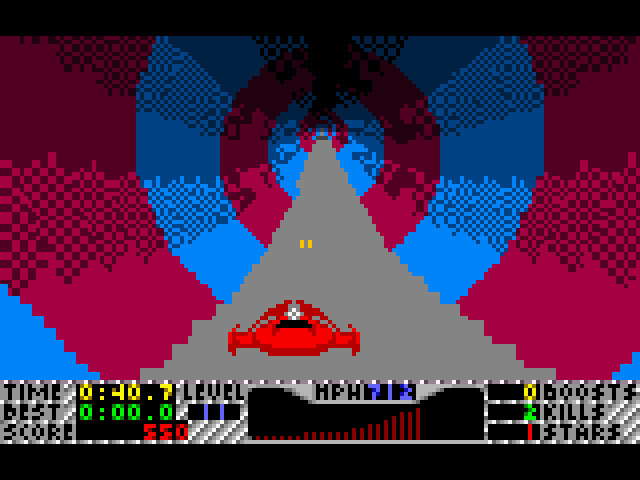
S.T.U.N. Runner is a futuristic racing game that puts an emphasis on combat and high speeds. (“S.T.U.N.” apparently stands for “Spread Tunnel Underground Network.”) Instead of merely racing from point A to point B, players will have the opportunity to eliminate road hazards with lasers, use ramps to launch themselves into the air, and drive upside down in tunnels. The arcade version of S.T.U.N. Runner was notable for its use of 3D polygonal graphics. The Lynx was obviously not capable of rendering these visuals, so the port relied on 2D scaling effects to simulate 3D environments. Because the screen on the Lynx was so small in comparison to the arcade cabinet’s, the graphical downgrade was not too much of a concern for most players. S.T.U.N. Runner was one of the most intense racing games of its era, and many of the aspects that made F-ZERO and WipEout so compelling were also seen in S.T.U.N. Runner. You’d be hard-pressed to find another game on the Lynx that can match its intensity.
2
Rampart
1992
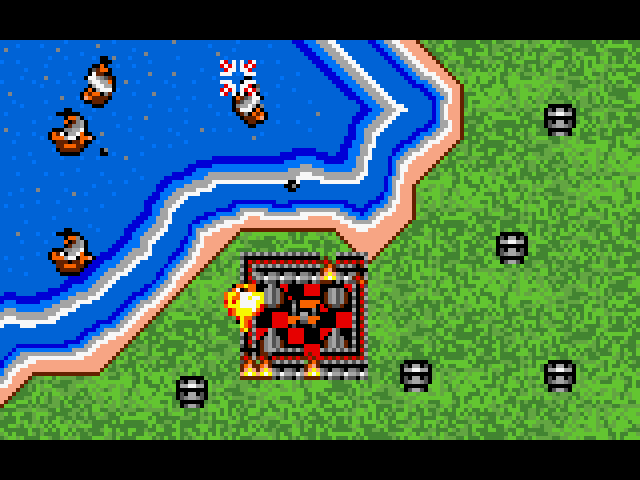
Without question, Rampart is one of the deepest games available on the Lynx. The game isn’t necessarily as accessible as the other games on this list, but it’s highly addicting once you get a handle on it. Rampart is basically a strategy game that incorporates elements from the shoot ’em up and puzzle genres. The objective of the game is to build a fortress and protect it from invading armies. There are multiple phases to the game, and various play mechanics are implemented. After the initial building phase, players take aim in an attempt to destroy fleets of attack ships. Once the attack phase is complete, players can repair their fortress by positioning blocks into place in a Tetris-inspired fashion. Players will have the opportunity to earn extra cannons and can also claim vacant castles in lieu of constantly repairing their starting castle. There are a lot of subtleties to Rampart, and the game really keeps players on their toes. The game takes a while to master, but it’s worth the investment.
1
Chip’s Challenge
1989
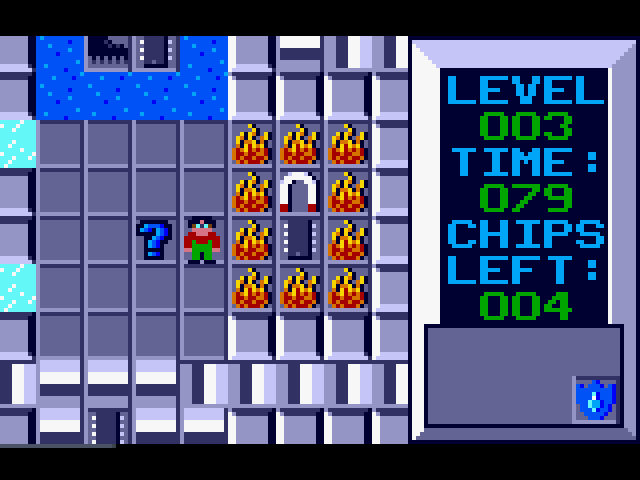
Chip’s Challenge is an overhead puzzle game that could be compared to the Adventures of Lolo series. The game consists of nearly 150 stages, and the level designs are absolutely brilliant. I’m truly impressed with how clever some of the stages are. In order to reach the end of each maze, players will have to solve numerous block-pushing puzzles, activate switches, and avoid enemies. The levels are filled with obstacles (including fire, icy floors, and conveyor belts), but players can find a number of items to help negate these hazards. (Boots will give players traction on ice, for example.) Chip’s Challenge requires players to exercise logic, and most of the stages have to be completed in a specific manner. The challenge can be somewhat frustrating, but the game gives players an infinite number of retries and provides passwords for each stage, so it’s hard to complain. The simplistic visual style and easy-to-understand interface makes Chip’s Challenge an ideal game for a handheld system. At the end of the day, Chip’s Challenge is a lot easier to pick up than it is to put down.



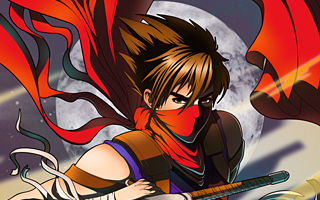
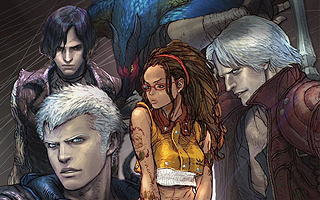
Do you agree with this list? Let us know what you think by leaving a comment below. Your opinion matters!